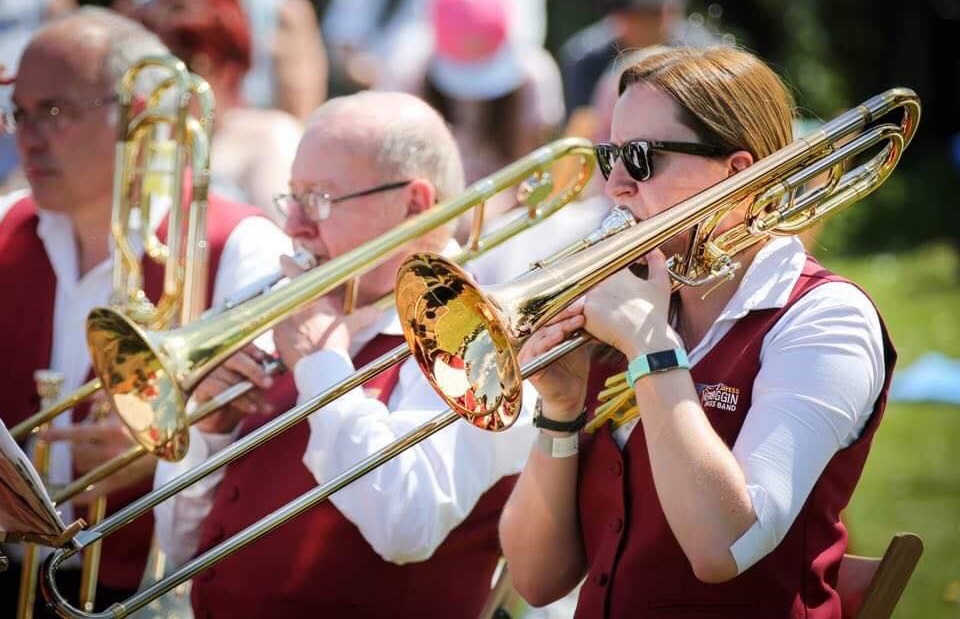
The trombone is a large brass musical instrument that in its basic, simplest form consists of a length of brass tubing, incorporating an extendable slide which allows a full chromatic range of semitones (corresponding to the white and black keys on a piano) to be played.
Like all brass musical instruments, the trombone has a mouthpiece which the player buzzes into to produce the note and, at the other end of the tubing, a flared “bell” which helps produce a good tone of sound. The pitch of the note depends on how the player buzzes and how far the slide is extended. As the slide is extended, the length of tube increases and the pitch of the note is lowered.


Trombones are very versatile instruments and can be found in many different forms of music from Brass Bands to Classical Orchestras; Jazz; Rock; Pop; Reggae; Ska; etc.
Brass bands typically have 3 trombones: 2 tenor trombones and a bass trombone. The 2 tenor trombones play music written in treble clef and are transposing instruments in B♭. The 1st (tenor) Trombone is a solo instrument and usually plays the melody or higher accompaniment. The 2nd (tenor) Trombone usually plays a lower harmony part. The Bass Trombone plays music in bass clef in Concert pitch (the same pitch as a piano), sometimes acting as a 3rd trombone adding a lower harmony to the 2 tenor trombones, or as a bass instrument alongside the tubas (known as “basses” in a brass band) but is also sometimes used to add colour to the music with its unique bass trombone sound.
The modern bass trombone is basically a large bore tenor trombone with some extra tubing that can be engaged using levers operated by the players left hand while their right hand works the slide.

The image above shows a typical modern bass trombone with 2 extra lengths of tubing on the left of the image. One of these extra lengths of tubing lowers the pitch by a perfect fourth (or 5 semi tones) and is known as an “F” key (because with the slide pulled fully in, engaging the F key lowers the note from a concert B♭ to an F). The other extra length of tubing typically lowers the pitch by a third (or 4 semi tones) so that when both extra lengths of tubing are engaged the pitch is lowered a minor sixth (or 8 semi tones), lowering the pitch from a concert B♭ to D. Other configurations can be used.
Modern tenor trombones often also incorporate some extra tubing with an F key to allow a fuller range of chromatic notes at the lower end of the instrument’s range, and to give options for playing notes in different slide positions which can be helpful in fast moving passages of music or when rapid and extensive slide movements would otherwise be required.
Trombones were developed over 500 years ago and were the first brass musical instruments that could play a full range of chromatic notes or semitones (the notes that can be played on a piano using white keys and black keys).
Early brass instruments had a fixed length of tubing so that only a limited range of harmonic notes could be played, just like a modern bugle. To allow other notes to be played, extra lengths of tubing (“crooks”) had to be added or removed but this was not very practical as it interrupted the playing during a performance!
Then some bright person thought of adding an adjustable crook – a length of telescopic tubing in the form of 2 pieces of tubing one of which could slide back and forth over the other. Thus was born the Slide Trumpet.

The slide trumpet was revolutionary in its time, but still limited because the tube could only be extended as far as the player’s arm could stretch, and this was not enough to allow a full range of notes to be played.
Later, another brilliant mind had the idea to bend the sliding part back on itself into a U shape, and thereby doubling the length of extendable tubing, and the trombone was born!
Trombones were made in a wide variety of sizes, from the small soprano trombone, the alto trombone, tenor, and bass. Until recently, bass trombones did not use extra lengths of tubing operated by levers, they were just bigger instruments with a very long slide which required a flexible handle so that the player could extend the slide fully. These were pitched in G and therefore known as “G” trombones, although F and E♭ trombones were also used.
For many years, trombones were the most used brass musical instruments because of their unique ability to play a full range of chromatic notes. Trombone quartets and other ensembles consisting of a mix of tenor, bass, alto and other size trombones, were widespread. The tradition of a trombone quartet to accompany congregational singing in Church still continues today in some churches.
Read more on the Yamaha website.